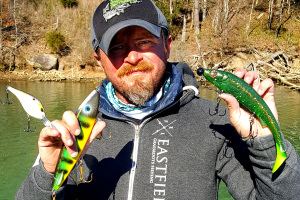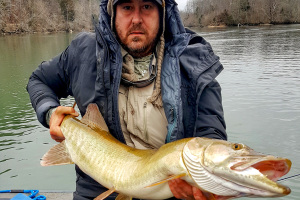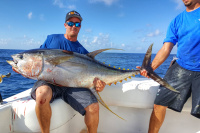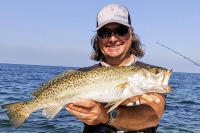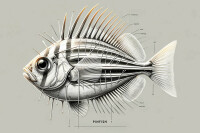The muskie fish, also known as the ski, musky, or muskellunge, is a mythical and devoted fish among anglers. Cory Allen, a musky fishing savant, teaches the importance of understanding depth and speed in catching muskie. He focuses on predictable routes between deep and shallow water, incorporating knowledge of the topography beneath the surface.

Muskie Fish - Freshwater Apex Predator
The muskie fish, aka ski, musky, muskellunge, Esox masquinongy, is the largest of the large member of the pike family. The fish confounds anglers more than it demystifies. It is called the fish of 10,000 casts for a reason. The words of musky fishing savant and cunning linguist Cory Allen capture the quest many an angler has set forth on, as they hunt for muskie.
“A figure of legendary superstition and a symbol of reckless ambition, few fish have created the cult of devoted acolytes that the muskie fish has. It comes as no surprise though, as nary a fish have the aura of mystique or misunderstanding surrounding them as this one does. Yet even the most grizzled warriors must lay down their blade and grab a goblet to share their tales and woes, and compare scars left by the fearsome muskellunge. As tumultuous and treacherous as any virago of mythos, the musky is nothing short of a siren singing on the rocks, chanting a shanty of valor and honor, alluring to anglers young and old alike.” - Cory Allen.
As a devoted adherent to the teachings of the legendary Buck Perry, Cory Allen taught me more about muskie than I could have possibly imagined. We formed a brotherly friendship along the way. The philosophy that Buck Perry established and the one Cory reinforces in his angling rests upon incorporating the proper understanding of depth and speed. If you are not at the right depth, you aren't going to catch many fish. If you are moving your lure too fast or too slow, you won't get many bites. The underpinnings of all this is knowledge. Knowledge of the topography that lies below the surface and how fish use it to migrate from deep water to shallow, always sticking close to the edge. Cory has a knack for visualizing the bottom and a crystal clear understanding of how to work contour lines. He knows that musky follow predictable routes between deep and shallow water. Those are the routes he focuses his fishing on.
Once you understand why and how musky utilize the subsurface topography, you will be in a far better position to capitalize on the bite when it happens. Muskie and most other fish seek refuge in deeper water. That is their sanctuary. Even it musky are in shallow water, they will usually have quick and easy access to deeper water. That access derives from the break line the fish followed. You can see this behavior in tiny bait fish along the bank. As soon as those bait fish sense danger or get uncomfortable, they flee to the depths following the contour fo the bank down. We have all watch this happen. All fish do this. It is all relative to the size of the fish and the type of structure.

Muskie Distribution
Muskie fish are primarily found north from Tennessee into the upper Mid-West and Northeast. Muskie really are the blue marlin of freshwater fishing. It is not caught everywhere, but there are definitely places you can go to and catch this apex predator. States with nice concentrations of big fish include Minnesota, Wisconsin, Pennsylvania, Tennessee and Michigan. You can certainly catch big fish in other surrounding states, but if you want desirably denser populations of big musky, go to those states. Many places in Canada support giant fish, too. The biggest fish I have ever seen was on The Winnipeg River System in southern Ontario. It was a shockingly big musky.
The common thread with the availability of muskie in a fishery is colder water. Colder water has a heavier concentration of oxygen and these apex predators need ample amounts of 02 to grow and feed the way they do. Even though Georgia, my home state, doesn't have muskie, there are plenty of lakes and rivers that would support the species. Given that they are not natural, they haven't been stocked like all the hatchery rainbow trout. If someone were to introduce muskie to lakes and rivers in north Georgia, the fish would thrive. The water temperature is right and the forage food is abundant. Just sayin'.
Be a Better Musky Fisherman
Sporting Qualities of Muskie
There is nothing like muskie fishing. Once you have seen a muskie fish come out of nowhere and smash a lure, roll on it and dive, once you experience that, there is no turning back. Muskie have an explosively viscous reputation. And it is well deserved. You will find no slack in their commitment, when it's go time. Equally endeavored to their complete indifference to your offering passing by their nose, muskie are enigmatic species.
To suffer a toad rolling up on your lure aggressively only to have it peel off and fade away is maddening and yet intoxicating. As is watching a muskie follow slowly behind your lure, watching and then turning off. Dedicating oneself to the quest of netting 50 inch fish is a real sickness.
The now you see it, now you don't modus operandi of muskie is synonymous with the camouflage this freshwater apex predator is suited with. Just like the movie “Predator”, where the creature appears tp blend in with its background. Muskie are the consummate ambush predator. Their coloration and total stillness make them damn near imperceptible. This cloaking ability is what they use to smash oblivious prey that get within striking range. Strikes can come from any direction. How many times have you had a fish come from under your boat to engulf your lure boat side? Yep. They clearly weren't following your lure. They were already there. Musky have an extremely sensitive lateral line that runs the side of their body. They can sense the vibration of a fish swimming by or the on left by your lure from two casts previous. With incredible vision and hyped up vibration sensors, there is nothing in the muskie fishes domain that it is not aware of.
Muskie are curious fish, with no natural predators. If I have heard it once, I have heard it a hundred times. “I had a huge fish follow my lure in. I just couldn't get it to eat.” With great eyesight, muskie fish are not shy to slide in behind your lure for a closer inspection. We have all had it happen where a tanker rolls in, tracks your bait, gets near the boat and disappears. Shit didn't look right. The one thing you can count on though is that musky need to eat. You don't get to 50, 60 or more inches without putting on the feed bag. From a sporting perspective, there is no greater challenge in freshwater than the pursuit of muskellunge.

Muskie Tackle
The most subjective aspect of musky fishing is the tackle. There is no end to it. I am not going to tell you what to go out and buy or push some company sponsor. There is lots of gear readily available that works. The best advice I can give you is buy the best rods, reels, line, leaders, hooks, lures and any terminal tackle you can afford. The best product may not be the one whose name you hear all the time. Sometimes it will, sometimes it won't. Be open to trying tackle from different manufacturer's. Experiment, especially lures. I have discovered some amazing lures trying out new stuff from folks I was not familiar with.
For the sake of tackle transparency, I am going to disclose the rods and reels that I use. Take from that what you will. My muskie fishing rods are from Fenwick and Tooth Tamer. Both are excellent for my style of fishing. These are rods in the 8' 5” to 9' range. That's what I like. My Fenwick is an fast action heavy rod for casting. The Tooth Tamer is an extra heavy rod, that I cast or troll lures with it. It is surprising how nimble the Tooth Tamer is pitching smaller lures. My reel of choice, at least the ones I have been using the last couple years, is the Abu Garcia Revo Toro Beast. Love the retrieve on it. Super smooth casting. It's robust. I can definitely say, I have put some mileage on the Abu's without any issues.
Muskie Lures
Cory Allen has a ton more experience than me chasing musky and especially big musky, so I deferred to him when it comes to my lure acquisitions. Most of the lures in my collection came by way of gifts from him, his recommendation or folks I had the pleasure of meeting through him. It's great to have friends with so much wisdom. Two guys whose lures I just love and use are Jase Bouldin and Roger Watters. Both of these guys are incredible craftsmen and fabricators. They don't just make a good looking lure, but ones that swim exceptionally well. While Roger, of H2O Lures is a commercial lure maker, Jase is a welder and amazing fisherman who just happens to make some of his own wares. I was fortunate enough that he gave me a few of his gems. My point with all of this musky lures and tackle talk is to emphasize the genius quality in some of the products that may not be all that familiar to you. I still like Suick lures, custom spinner baits from Joe Murphy and H2O Tackle.

Muskie Nets
If you do enough musky fishing, you will discover that the typical big net is not big enough. With so many fisheries holding fish in the 50 inch range, you just can't risk not having a legit musky net. The size I am talking about may seem a smidge over the top, but fear not. When that super tanker you will be glad that you took the time and spent the money on a dedicated musky net. Would dimension of 36″ W x 40″ L x 48″ depth shock you? I shouldn't. The net I use and most of the fishermen I know, who pay attention to quality, use is the Muskie Mag from https://rsnetsusa.com/.
I will never forget the giant musky I encountered in Canada, as a child. The one that I mentioned earlier from Ontario. My brother was working a large, rather crude, topwater lure down a weed edge when this absolute beast emerged from grass and devoured the lure. Shortly into the valiant battle it hit me. We're going to need a bigger net. I scooped the musky by the head and yet two thirds of its body was flopping out of the net. With on flip of its body, the musky threw the lure and slipped into the water. Off it swam. I will never forget the look on my brothers face. It was a crushing blow and a valuable lesson. Use the right gear.
How to Catch Muskie
The quest to catch muskie is just that, a quest. You can spend days on end chucking lures, soaking baits and get zilch. On the flip side, you might get a half dozen fish by lunch. The rubber meets the road in where you start your quest. Knowing where muskie will stage throughout the year will help shorten the time between catches. It is always a good idea to start your search in areas of transition. This could be on fallen timber, grass flats, mud or gravel bottom, deep water, plunging shorelines, creek mouths, deep holes, specifically where one type of topography or structure transitions into another type of structure. More times than not, a break-line or area of transition will hold fish. The smallest change is all it takes. This is why knowing the fishery will help you pinpoint areas to concentrate your fishing efforts.
Muskie are also inclined to positions themselves in or near temperature breaks, thermoclines, current seams, eddies or any other type of none physical structure. Moving water against slow water is a form of structure. All of these physical and non-physical areas of structure will be places that hold smaller fish, which serves as food. Work these areas well by casting lures, trolling lures or soaking baits. Take your time and hit the spots fro multiple sides. Sometimes it is just a matter of which direction your presentation comes from that triggers a bite.
If you want to know far more about the specifics of seasonal techniques, lures, jigging, casting, trolling in lakes, rivers, reservoirs, creeks take some time to preview our Muskie Fishing Videos. You will find a wealth of information on time tested tactics and techniques. Each video will enable you to watch, listen and learn from some very talented musky fishermen. The level of articulation will set you up for success fishing for musky in any fishery. I feel the most important element of our muskie fishing videos is the why you should do something. Just telling an angler to do something doesn't necessarily help them learn the fundamentals. Giving deep explanation of what the fish are doing, what fishing techniques will help them and why broadens the knowledge offering. If you have any questions, please don't hesitate to reach out to us. We are always happy to help. Go will knowledge and catch more muskellunge.



